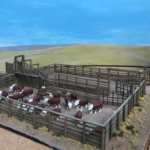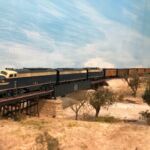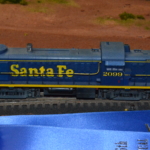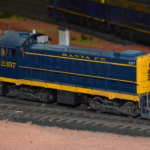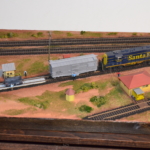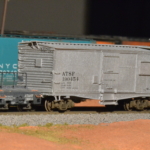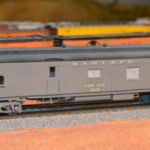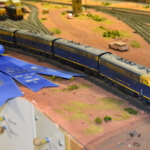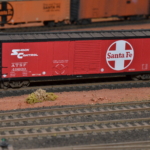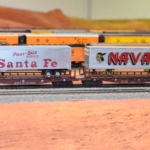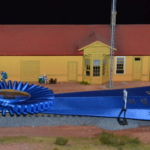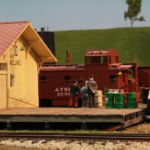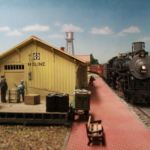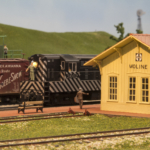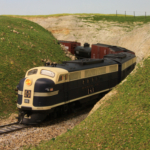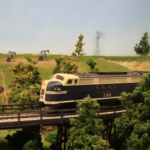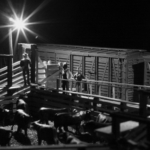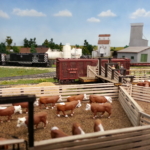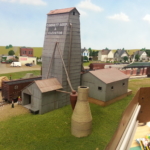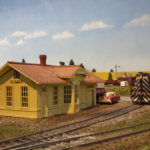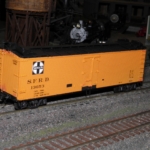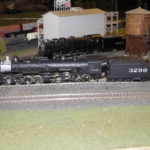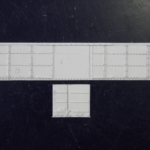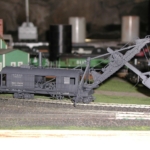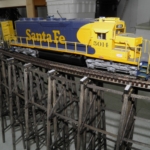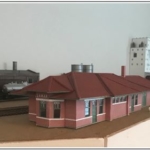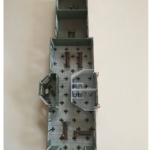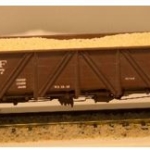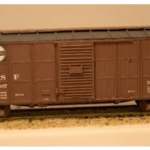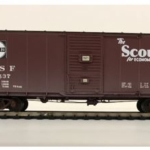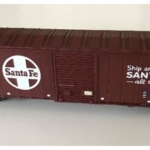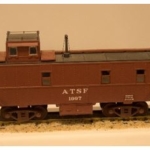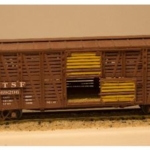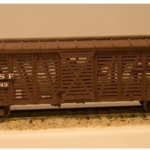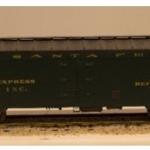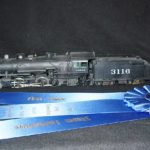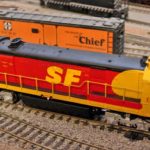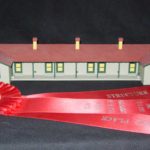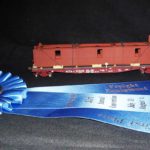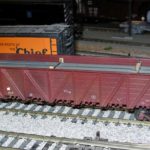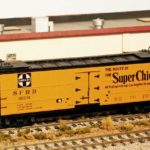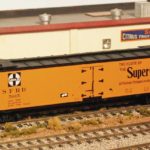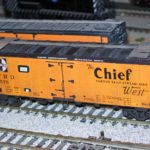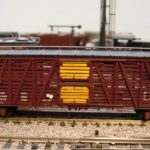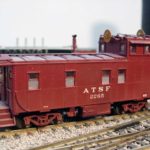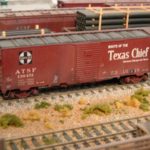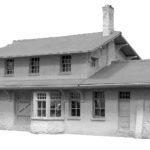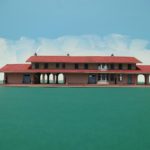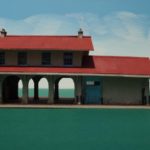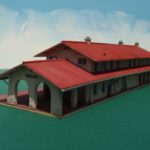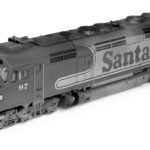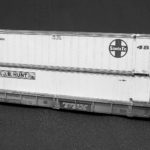On this page, we recognize those individuals recognized as “Master Santa Fe Modelers” by the Society based upon their expertise in modeling all aspects of the Santa Fe, including structures, motive power and rolling stock.
BILL VAN DER MEER, MASTER SANTA FE MODELER NO. 7
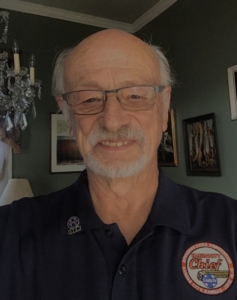
First of all, I can’t tell you how honored I am to be included in this fraternity of individuals who have earned the distinction of “Master Santa Fe Modeler”. I look around me to those who are present and those who have passed away whose work has inspired me over the years. So in a very real sense I feel like I’m standing on shoulders of giants with this designation. Thank you very much!
Bio
Bill Van der Meer has had a lifelong love of trains both big and small. He’s been playing with trains ever since he got his first Lionel set at age six, then switching to HO scale at thirteen. The offspring of Dutch parents, he and his family has lived in Canada, the Netherlands and Washington DC where he spent most of his formative years through early adulthood. Bill currently resides in New Orleans with his wife, Mary. During his 23 year tenure at Pennsylvania College of Technology in Williamsport, PA, Bill developed educational programs, conducted classes, and authored technical briefs and field guides for aspiring building professionals. He closed out his career as a technical consultant to the US Department of Energy and Oak Ridge Institute for Science and Education in Oak Ridge, Tennessee.
How did you get interested in modeling the Santa Fe?
My interest in modeling HO scale Santa Fe branch line operations got its start when I happened to pick up a copy of a December 1981 issue of Model Railroader magazine. That issue featured a cover story about John Allen’s spectacular model railroad, “The Gorre and Daphetid”. Gazing upon page after page of sheer artistry, it was like running into an old friend. After an 18 year absence from the hobby I was hooked again. In those early “daze” I still lacked an appreciation for prototype operations to achieve the realism I was after for a western themed layout. While bouncing around between various railroad flags, I initially toyed with Shay locomotives and the idea of a closet shelf switching puzzle depicting a New Mexico operation that milled and shipped railroad ties to the Santa Fe in the early 20th century. My railroad buddies in the heart of Pennsy and B&O country wondered aloud why I eventually chose to model the Santa Fe. The stark and austere beauty of the landscape through which it traveled, its awesome motive power, the exquisite name trains, and the brand itself were some of the major reasons why. Also extremely advantageous were the wealth of historical information and technical resources currently available through the SFRH&MS. That is not to mention the exposure to an abundance of commercially available kits, brass imports, photos, system standards and networking opportunities with like minded Santa Fe modelers
After roughly ten years of research, model building and kicking up cinders along the nearly abandoned Santa Fe branch line rights of way in Texas, Oklahoma, and Kansas, I felt I had enough on-site information to replicate the ambiance and textures of the branch line theme I was about to model. Books such as Coach Cabbage & Caboose, and The Doodlebugs by John McCall along with E.D. Worley’s Iron Horses of the Santa Fe Trail were my constant companions. At last an opportunity arose when we purchased a basement (with house attached). It was there where I eventually built my Sweetwater and Orient Ry (S&O). The winding, fifty five foot long point to point railroad had a variety of scenic elements that typified the geography of the southern great plains. Bringing up the markers were the motor cars and mixed trains that served the small communities along the way. As an afterthought I submitted photographs and a narrative to Kalmbach Publishing who (thanks to the late executive editor, Andy Sperandeo) ran a cover story about my finished project in the February 2003 issue of Model Railroader magazine.
Fast forward to between 2016 and the present and I’m now into a new basement space. With the exception of finishing the scenic detailing, this updated version is nearly complete. Its official moniker is the Sweetwater and Orient Ry, but I often refer to it as “The Shoehorn Division” (so called because it incorporates heavy mainline railroading complete with five track staging around the walls in a modestly sized 18X16 foot space). Although a future peninsula for a branch is possible, its major theme and motive power is more akin to the Slaton to Sweetwater segment of the GC&SF Plains Division.
What would you like to share with other modelers?
The really neat thing about model railroading is that it’s so multifaceted. Be a town planner, a carpenter, bridge engineer, yardmaster, landscape architect, mechanical department head etc. Sometimes it’s about one or two chosen roles and sometimes all of the above. That’s especially true if and when you embark on that epic journey of building a layout. Some of us never get to that level. Some may be interested in research and/or collecting alone. Others may find fulfillment by diving into the historical aspects, authoring, or standing trackside with camera in hand. But whatever path we take, it’s all good. What we do have in common is that it all begins with a passion, which ultimately leads to a desire and commitment of putting hands and heart to work.
As far as modeling is concerned, remember that it’s your railroad and you have the freedom to determine its scope, level of participation and attention to detail. You’ll be your own worst critic in that respect. I would highly encourage participation in clubs, mini meets, and national conventions.
I have personally met so many interesting people in this organization and throughout the model railroading community who might never have come together under any other circumstances except for a common love of dreaming and following the creative pursuit that is our craft. I’ve discovered that completing a project isn’t nearly as important as the process itself. And as it relates to any artistic venture you have to slow down in order to truly enjoy it.
– Bill Van der Meer
Gallery of bill van der meer modeling
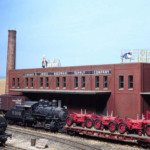
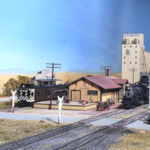
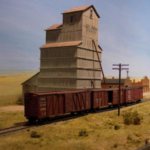
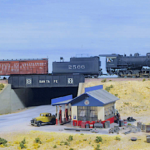
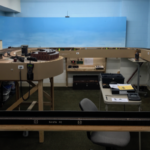
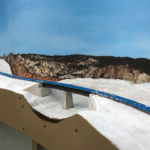
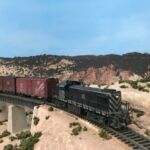
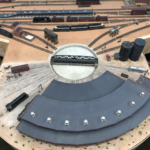
bruce mckeown, Master Santa Fe Modeler No. 6
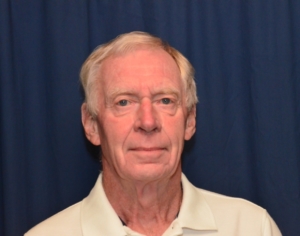
Where do you live? I live just outside Louisville, KY, but my long term homes have been in the Chicago, Il area. I arrived here in 1998 to begin a career with UPS Airlines, conducting pilot flight training in the Louisville Flight Training Center. Prior to that I had a 20-year career between 1969 and 1989 in naval aviation, moving between California, Florida and Virginia.
How did you become interested in the Santa Fe? In high school in the early 1960s while working part time in a hobby shop, my first HO locomotive purchase was a Revell Santa Fe F7 in the blue and yellow freight scheme, because I liked how the locomotive looked. An Athearn Santa Fe caboose followed, and many freight cars from the kit makers of the time. My model railroad was only in place during the winter months, but I continued throughout the year to build model kits. Even though I did not have a model railroad during my college and military service years, I continued to build models, hoping someday to have an opportunity to have another model railroad. I set an artificial equipment timeframe limit of mid to late 1967, the last year I worked in the hobby shop. All my models are as they would have been seen in service at that time. Without the likelihood of having to move as was the case when in the military, in 1991 I was finally able to build a model railroad. Still keeping things accurate to 1967, I began a process of replacing all the equipment I had previously accumulated with the newer, better quality, more detailed and better fidelity models available. This also began my process of adapting models for specific equipment, and making models of unique Santa Fe equipment.
What would you like to share with other modelers? Through my modeling work I hope to show other modelers that there can be more to modeling the Santa Fe, and equipment from other railroads, than just purchasing a model off the shelf and placing it on their model railroads. Throughout the process I embarked on to replace all my older, less accurate equipment, I’ve strived to keep models true to their prototype. Building or modifying existing kits and/or adapting ready built equipment is possible to achieve the desired results. There is a wealth of detail parts available, and in many cases scratch building piece and part items is not as difficult a task as many assume. My skill level increased with practice, which led me to entering some of my models in the Convention contests. All of my models are in regular use on my railroad – nothing sits on the shelf or packed away in a box.
The Rolling Stock Reference Series of publications from The Society has been a valuable resource for modeling information – how equipment was configured and looked, the timeframe the equipment was in service, variations and other detailed information – have helped with my model building, as well as information shared by Santa Fe railroaders and historians. I am grateful to the members of The Society that have judged my models worthy of recognition for individual awards and the Master Santa Fe Modeler designation.
steve sandifer, Master Santa Fe Modeler No. 53
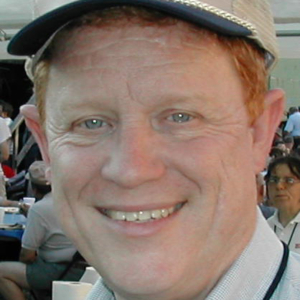
Steve Sandifer has lived in Meadows Place, Texas (a suburb of Houston) since 1991. He moved to Houston in 1977 to become one of the ministers of the Southwest Central Church of Christ, where his family still participates, though he formally retired in 2014. Steve received his first Lionel Warbonnet the Christmas of 1949 when he was 18 months old. Even though his grandfather was Supervisor of Passenger Service for the KCS, the Santa Fe became Steve’s focus. In junior high he swapped his Lionel collection for HO and took over the family attic for his new empire, learning carpentry and scratchbuilding in the process. His father had an endless supply of crate wood and a good woodworking shop, so Steve was able to duplicate TrueScale roadbed to provide track for his layout.
With university, grad school, marriage, family, and mission work, there was no room or money for trains, but his camera was kept busy documenting things for the future. Finally the last son graduated and started his own family, so there was a spare bedroom for a new layout. That bedroom was enlarged to a 14×20 room, large enough for a good operating layout.
In his research for a Santa Fe prototype location, Steve wanted a division yard and a branch line. The division location needed to be on the transcon so that anything would look at home heading through. The branch was to produce some lazy operations without the pressure of a fast clock or time sensitive interchange. After discovering James Burke’s “The Iron Horse and I,” he chose Emporia and the Howard branch. The steam-diesel transition of 1952 is his target date, though that date is somewhat flexible. The Howard District was in the edge of the Flint Hills, and Emporia had an enormous live stock feeding station. These facts led Steve to research “Santa Fe’s Live Stock Operations,” published by the Society in 2019.
In Houston Steve is a part of the San Jacinto Model Railroad Club and enjoys operating sessions with his club mates. He is a member of the NMRA, a Master Model Railroader #389, and the NMRA OpSig. He has served as a consultant to Broadway Limited, Lionel, and Rapido on Modeling projects. He joined the Santa Fe Historical and Modeling Society around 1997 and attended his first convention in 2003. He served as Webmaster from 2006 – 2016 and was awarded Honorary Life Member in 2015 and Master Santa Fe Modelers in 2018. Steve and Jo have been married 50 years and have two grown sons and six grandchildren.
Ian MacKellar, Master Santa Fe Modeler No. 4
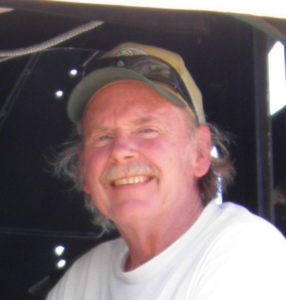
Ian MacKellar is Master Santa Fe Modeler #4. He has an interest in 1930s Santa Fe models.
I have lived in Canton, NY near the Canadian border since 1981. The CSX line from Syracuse, NY to Montreal goes past the back of my house. I was a large animal dairy cattle veterinarian here for 35 years.
I got interested in SF because when I was young I lived in the NY southern tier where Erie Lackawanna and Lehigh Valley operated. I am quite colorblind seeing only blues and yellows. As a young colorblind kid do the gray and reds of those eastern roads inspire much interest? I don’t think so, but there was a railroad with blue and yellow locomotives in the hobby shop, Santa Fe. My first loco was a blue and yellow Tyco GP20, an awful model but the start of my Santa Fe interest. Then the steam bug hit me and when I got older I learned about billboard reefers. Net result is my interest in SF steam and my modeling 1934, the height of the billboard reefer era.
I model SF steam from the ’30s but also have some diesels from the mid-90’s. My main focus has been freight cars of the same era with lots of reefers and lots of resin kits. I also have enjoyed scratch building several cars some of which have been released commercially by Westerfield. I build craftsman structures too, though none of them are SF specific, except for the trestle I showed in Pueblo last summer.
To share with other modelers. First and most importantly remember that this hobby is supposed to be fun. Do what you enjoy with it. Just because others are doing X,Y, or Z doesn’t mean that is the only way to participate in the hobby. I like building models and have no interest in DCC, or operations so I build models and my layout collects dust. If you don’t like to build or don’t have the eyes for it, run trains or learn the history of them. Keep it fun so that you want to do it and it is not a chore.
Denny Krausman, Master Santa Fe Modeler No. 3
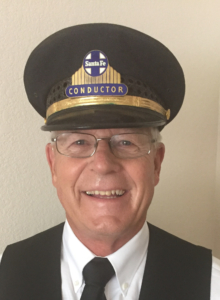
Denny Krausman has lived for the past 20 years in Lone Tree, Colorado, which is a community in the southern Denver metro area. Prior to moving to Lone Tree, he lived for 20 years in Parker, Colorado and grew up on an Iowa farm bisected by the Milwaukee Road.
How did you get interested in modeling the Santa Fe? When I began modeling in the early 70’s my layout was a Midwest freelance railroad, the Sioux City and Western. The motive power was steam with a mix of CNW and Illinois Central, but I always liked the looks of Santa Fe’s modern steam power and of course the Silver and Red Warbonnets. When we moved to Colorado in the early 80’s I decided to model the Santa Fe as I would be starting over fresh with a new layout. While the layout got build in 5+ years the motive power and rolling stock took about 10 years to get phased in. In 2000 when we moved to Lone Tree, I decided to build a new layout that was designed for operations and would be constructed to a specific area that matched the prototype. The area was a portion of the Colorado Division, First and Second Districts in western Kansas and eastern Colorado centered on Holly, Colorado, which was the eastern terminus of the Second District, “The Arkansas Valley District.
What aspects of modeling to you enjoy most? I enjoy scratch building, kit bashing, and kit building prototype Santa Fe Structures and Rolling Stock. My layout is dated July 1st, 1948 to June 30th, 1949 and I try to model and operate motive power, structures, and rolling stock to this timeframe. In order to do this, it requires a lot of scratch building and kit bashing to create this effect.
What would you like to share with other modelers? While many modelers don’t always share my interest in scratch building and kit bashing, I do encourage everyone to a least build a few resin kits to create prototype equipment as it is not the difficult once you get a little experience and learn a few simple tricks, i.e. attending clinics on resin kit building.
Here are some examples of Denny’s work. Click on the image to get a better view:
Charlie Slater, Master Santa Fe Modeler No. 2
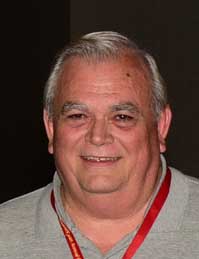
Charlie Slater has lived in Bakersfield, California since 1989 and before that in Needles, CA from 1984-1989. He grew up in Lakewood, CA. When he went to work for Santa Fe he just relocated with his job when he needed to do so. Charlie worked for the Los Angeles Junction Railway from 1970-1984 as a Switchman, and for the Santa Fe and then the BNSF from 1984-2006, when he retired with 36 years of service.
How did you get interested in modeling the Santa Fe? As a teen in the early 1960’s my train buddies from high school and I would ride our bikes up to L.A. on weekends and visit the Santa Fe and UP. East L.A. yards for the day. At that time you could go just about anywhere on railroad property with no problems. It was not uncommon to get a cab ride on switch engines around the yard. Sometimes if an east bound freight was sitting in the yard waiting to highball the Engineer would invite you up into the cab and give you a tour, of course when the Brakeman would start lining switches out to the main line it was time to get off. The Santa Fe people were always the nicest and I really liked their F-units colors. I started modeling the Santa Fe in 1961 as a teen member of the Long Beach Model RR Club and have been modeling it ever since never dreaming that one day I would go to work for them.
What would you like to share with other modelers? I always try to encourage people to model the Santa Fe as it was always one of the class railroads in the country, and everyone knows what the red/silver warbonnet looks like and what the Super Chief and El Capitan were. They always had an interesting locomotive fleet that was kept pretty clean. And for me they had a lot of their own design freight and passenger cars to make it interesting. I really would like to see more people building models instead of just buying them and taking them out of the box and running them. I really admire the people who take the time to build something and bring it to one of our conventions so we all can see what they built.
Photos of Charlie’s work follow. Click on the photo to see a complete view (the gallery program clips the edges). Enjoy!
Jürgen Dietrichkeit, Master Santa Fe Modeler No. 1
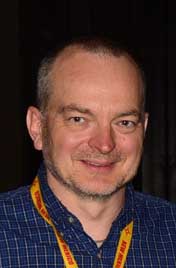
In Jürgen Dietrichkeit’s case, not only did his Vaughn, New Mexico depot win the President’s Award for Technical Excellence, it also won Best of Show and completed, with his prior ribbons and publications, the requirements for the Society’s new Master Santa Fe Modeler recognition, making him the first recipient. Photos of some of Jürgen’s models over the years appear below. We took the liberty to find out a bit more about Jürgen to share with our readers. Congratulations to Jürgen for excellent and inspiring model work!
Where do you live? I live in the city of Weilheim, south of Munich (native!), Germany, in viewing distance of the Alps and less than an hour from places like Garmisch, Oberammergau and Neuschwanstein Castle, and less than two hours from Italy.
How did you become interested in the Santa Fe? I got into trains through my Dad’s modeling Märklin since the early sixties. In his family were several career railroaders working for the Deutsche Reichsbahn (by-line: my Great-Grandfather was a railroad soldier who spoke four languages, and he was an interpreter at the signing of Germany’s WW I capitulation in 1918 at Compiegne, France), and Deutsche Bundesbahn after WW II.
Visiting my mother’s pen friend in California in 1983 when I was a very impressionable 16-year-old. My first ever Santa Fe impression was a seven-unit, 128-car freight train in Barstow, something we just were not used to seeing in Europe! Touring AZ and CA on that trip gave many more RR impressions. Looking back, it could have been SP or UP, but it was that pen-friend’s Dad who took me to the ATSF Bakersfield yard and up Tehachapi that got me “Santa-Fe’d.” I joined the Santa Fe Modeling Society in 1987 and started modeling Santa Fe fully in 1989. Since the ATSF died in 1995, my modeling world since then is ending on Sept. 21st, 1995. At that time, the Superfleet, international and domestic intermodal traffic, the Transcon pipeline of trains, all were in full swing.
HO-scale was a natural choice for me but sometimes I wish I was in N-scale because of that better train-scenery ratio. I’m way too deeply invested now to change it. Recreating that certain date in time on the railroad as closely as possible (within reason) is what I’m striving for. Modeling the Clovis Sub is what I decided on when we had that new house built in 2007. Busy single track, lots of local flavor (depots!), little online traffic, super-hotshots, and my favorite RR location of all, Abo Canyon, got me inspired. I enjoy following and photographing the BNSF but I’m leaving it to my two teenage sons on the modeling side. My railfanning goes far enough to hire a helicopter in 2011 to fly over Abo and Belen, shooting pictures in a biting cold in January.
I have spread the spirit of US-style railroad modeling through my local network having inspired several local club members to build Fremo HO USA modules that we join twice a year to form a monster layout, attracting followers from Switzerland and Luxemburg. What I’m enjoying most, though, is the relationships and camaraderie with other “trainy” folks from all over the world. Many of those have become personal and family friends over time that come to see me and the layout, or are happy to have me (plus family) over at theirs. Some I got to meet out there shooting pictures at places like Curtis Hill in OK, or at mini-meets, train shows (Springfield, MA), or conventions (13 since Chicago 2000), or via the internet. Glad we got this kind of communication channels today! My hobby to this degree would not be possible without modern technology. Try modeling Brenner Pass in the seventies from over there without modern communication!
Click on any of the images to see a larger version.
9
